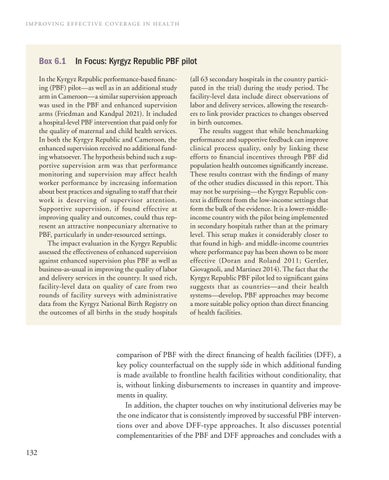IMPROVING EFFECTIVE COVERAGE IN HEALTH
Box 6.1 In Focus: Kyrgyz Republic PBF pilot In the Kyrgyz Republic performance-based financing (PBF) pilot—as well as in an additional study arm in Cameroon—a similar supervision approach was used in the PBF and enhanced supervision arms (Friedman and Kandpal 2021). It included a hospital-level PBF intervention that paid only for the quality of maternal and child health services. In both the Kyrgyz Republic and Cameroon, the enhanced supervision received no additional funding whatsoever. The hypothesis behind such a supportive supervision arm was that performance monitoring and supervision may affect health worker performance by increasing information about best practices and signaling to staff that their work is deserving of supervisor attention. Supportive supervision, if found effective at improving quality and outcomes, could thus represent an attractive nonpecuniary alternative to PBF, particularly in under-resourced settings. The impact evaluation in the Kyrgyz Republic assessed the effectiveness of enhanced supervision against enhanced supervision plus PBF as well as business-as-usual in improving the quality of labor and delivery services in the country. It used rich, facility-level data on quality of care from two rounds of facility surveys with administrative data from the Kyrgyz National Birth Registry on the outcomes of all births in the study hospitals
(all 63 secondary hospitals in the country participated in the trial) during the study period. The facility-level data include direct observations of labor and delivery services, allowing the researchers to link provider practices to changes observed in birth outcomes. The results suggest that while benchmarking performance and supportive feedback can improve clinical process quality, only by linking these efforts to financial incentives through PBF did population health outcomes significantly increase. These results contrast with the findings of many of the other studies discussed in this report. This may not be surprising—the Kyrgyz Republic context is different from the low-income settings that form the bulk of the evidence. It is a lower-middleincome country with the pilot being implemented in secondary hospitals rather than at the primary level. This setup makes it considerably closer to that found in high- and middle-income countries where performance pay has been shown to be more effective (Doran and Roland 2011; Gertler, Giovagnoli, and Martinez 2014). The fact that the Kyrgyz Republic PBF pilot led to significant gains suggests that as countries—and their health systems—develop, PBF approaches may become a more suitable policy option than direct financing of health facilities.
comparison of PBF with the direct financing of health facilities (DFF), a key policy counterfactual on the supply side in which additional funding is made available to frontline health facilities without conditionality, that is, without linking disbursements to increases in quantity and improvements in quality. In addition, the chapter touches on why institutional deliveries may be the one indicator that is consistently improved by successful PBF interventions over and above DFF-type approaches. It also discusses potential complementarities of the PBF and DFF approaches and concludes with a 132

